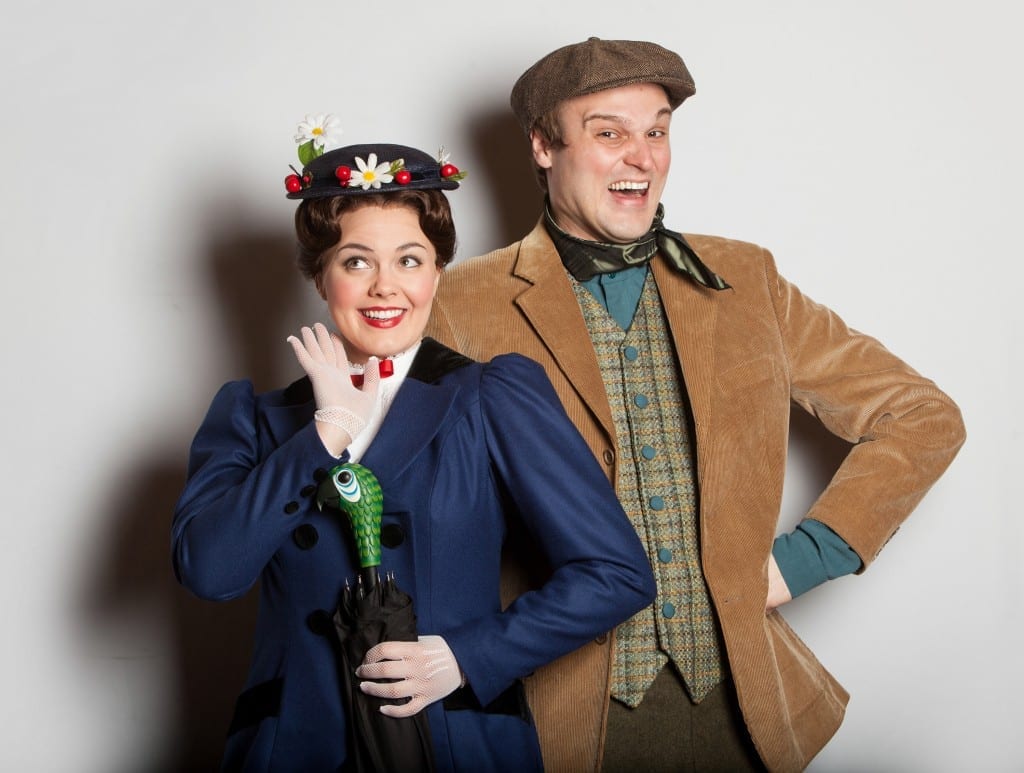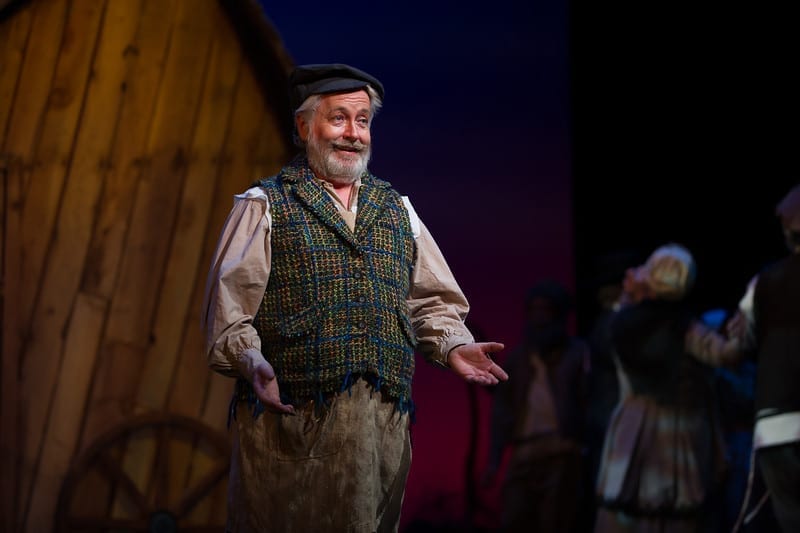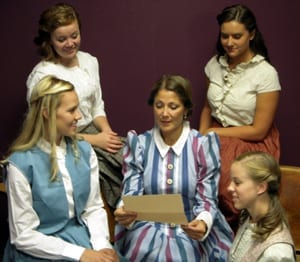WEST VALLEY CITY — There is a scene in both the movie and the stage production of Mary Poppins wherein the title character pulls a series of large objects out of a seemingly ordinary carpet bag, much to the astonishment of the Banks children. Happening in a brief moment, this sequence sums up the mystical abilities of the Banks’s nanny: to bring good things out of places where they somehow, impossibly, already existed. Disney’s stage version of Mary Poppins is based on the stories of P.L. Travers and the Walt Disney film, with theatrical book by Julian Fellowes. It features original music and lyrics by Richard M. Sherman and Robert B. Sherman and additional songs by George Stiles and Anthony Drewe.
From the moment Mary Poppins (Kimberly Olson Bunker) inexplicably answers an advertisement which had been torn and thrown into the fireplace, she sets to work finding the best in every situation. With the help of her friend Bert (David Smith), Mary Poppins finds adventure in the sidewalk art and and the exciting night life of the chimney sweeps atop the roofs. More importantly, she helps find charity and gratitude in Jane (Abigail Edwards) and Michael (Anson Bagley), courage and confidence in Mrs. Winifred Banks (Michelle Blake), and warmth and kindness in Mr. George Banks (Douglas Irey). Mary Poppins even manages to pull together a family from what had once been only a collection of individuals sharing the same roof.
In this Hale Centre Theatre production directed by John J. Sweeney, there was a much more theatrical magic at work than just a large carpet bag. Hale is known for its theater in the round, played on a small stage with seemingly endless possibilities. The primary configuration designed by Kacey Udy and used throughout this production consisted of a ring-shaped rising platform which rose or descended to facilitate scene changes. Each time it rose, it did so fully furnished for the next scene, often with the actors already in place for the next scene. I found myself wondering at the vast responsibilities of scenic change artists Jessica Berg and Shana Merton who transformed this space to alternately represent the Banks estate, a beautiful carousel, and a ready-for-disaster kitchen. As the central platform descended, it became the responsibility of lighting designer Adam Litton to change the scene. I enjoyed watching the variety of special lighting effects used to create flowers, an alphabet motif, and a cathedral. The capabilities of this theater-sized carpet bag didn’t end there. A fully furnished children’s bedroom dropped from the ceiling whenever the scene followed the Banks children to their room. Set carefully, this set piece interacted with the capabilities of the moving floor beneath it to facilitate Mary Poppins’ magic in “Practically Perfect” and “Playing the Game.”
Several of the show’s performers were outstanding, even against the constant backdrop of stage magic. Smith’s renditions of “Chim Chim Cher-ee” were hauntingly beautiful as his smooth voice seemed to float over the notes. He also showed mastery of Jenny Barlow‘s complex choreography, especially in “Step in Time” and “Supercalifragilisticexpialidocious.” Nelius (Matt Davies), a statue come to life, was captivating to watch each time he danced. The power he used to leap made him look strong, a contrast to the sadness he expressed over missing his father during his interactions with the Banks children. Both Edwards and Bagley maintained a consistent accent while working to be simultaneously precocious and adorable. While Bagley’s strength lay in his direct, wide-eyed delivery, I appreciated Edwards most for her ability to hold the required harmonies often occurring in the final notes of small group songs such as “Practically Perfect” and “A Spoonful of Sugar.” While I was impressed with each actor and actress tasked with delivering Barlow’s intensely intricate choreography on “Supercalifragilisticexpialidocious,” I was amazed when both Edwards and Bagley kept up with every step.
As Mary Poppins, Bunker was poised and eloquent, and I appreciated her attention to diction since she carried much of the dialogue throughout the production. She consistently held every detail of her posture in a way that contributed to her character’s solidarity and arrogance. I was frequently amused by her perfectly timed delivery of well-written lines which showed her the unbounded ego of her character. Her response to Jane’s misgivings about the flavor of her medicine, “I’m not sure I care,” was a response I will think of frequently when speaking with my own children. Add to her character a strong, clear voice and clarity of movement, and I would have to agree with Mary Poppins’s assessment of herself. Bunker as Mary Poppins really was “practically perfect in every way.”
Another practically perfect character in this production was Irey as Mr. George Banks. Playing the role which required the most growth throughout the show, Irey smartly began with a portrayal of a Mr. Banks so rigid he nearly seemed a caricature. By the end, however, as Irey danced around with a segment of the complex “Supercalifragilisticexpialidocious” choreography, he showed his complete reversal. For me, the new Mr. Banks was the best thing to come as a result of Mary Poppins’s magic.
The best aspect of this production was how seamlessly the entire production staff worked together to deliver stunning moments. One example was during “Jolly Holiday” when Sweeney’s vision, Louise Pascoe’s costumes, Barlow’s choreography, Udy’s scenic design, and Kelly DeHaan‘s musical direction all came together in one unbelievable production number. Mary Poppins and Bert wore the iconic red and white costumes from the movie as they danced with a tasteful take on penguins (in this case, waiters) moments before Jane and Michael rose on an amazing carousel. Another example was during “Step in Time,” during which individual spotlights shone directly down on individual dancing chimney sweeps, adding another layer to the already impressive choreography. The lighting changed in time to the music, showcasing a different dancer or set of dancers in sequence. Also impressive in this production number was Bert’s ascent to the top of the chimney. Any description I tried to give would do the moment a disservice, so I will just have to say that I was captivated. Finally, the umbrella motif used in a variety of scenes added another layer to the entire production. I enjoyed watching to see how umbrellas might be incorporated as the show went on. My favorite of the umbrellas was the first, which rose in fog and lifted a model of the outside of the Banks home. I felt goosebumps on my arms as I realized that I was about to witness something amazing.
Amid all this technological magic, however, there was one area in which I fear they may have taken it too far. Although I cannot state it with certainty, the chorus sounded prerecorded on many production numbers including “Supercalifragilisticexpialidocious” and “Step in Time.” If that is truly the case, the choice to prerecord is disappointing to me. While I believe in the magic that can be created using technological effects, I think live voices are an important part of live theater. If I am incorrect in my accusation, the ensemble should take this as compliment to their full sound and abilities to execute exhausting production numbers without sounding winded.
Thanks to the combination of onstage talent and backstage magic, Mary Poppins fills the Hale Center Theatre stage to the brim with excitement. This production tells a classic story in a way that perhaps only Hale Center Theatre can. Whether you love Mary Poppins, you’re ready to experience the story in a new way, or you want to share a classic with a new generation, this is not a show you’ll want to miss.







